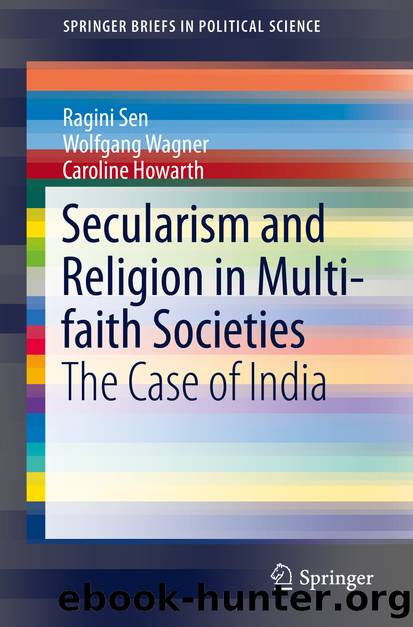Secularism and Religion in Multi-faith Societies by Ragini Sen Wolfgang Wagner & Caroline Howarth

Author:Ragini Sen, Wolfgang Wagner & Caroline Howarth
Language: eng
Format: epub
Publisher: Springer International Publishing, Cham
3.4.1 Sarvadharma Sambhav (Peaceful Coexistence of all Religions)
As opposed to the common western concept of secularism, Gandhi suggested Sarvadharma Sambhav to prevent conflicts caused by religious bigotry. Gandhi was not concerned with the American idea of the separation of church and state because he felt that in India religion is so powerful in the social order that the western concept of secularism did not make much sense in the geo-cultural context. The following data reveal that this is a concept, which is endorsed by many. However amidst the Muslim respondents there was greater preference for the concept of peaceful existence and reticence towards the term Sarvadharma Sambhav. This was not overtly stated, but discomfort and reluctance were observed when the Muslim respondents would articulate this Sanskrit term. When the interviewees were asked about secularism three themes emerged: endorsement of the concept: “definitely, I would prefer to opt for that secularism which respects every religion and wants peace in society. If a person is religious and also gives due respect to religion of others then there would be harmony and brotherhood in the society. Be like Gandhi and follow Sarvadharma ways” (H m lc 9); hijacking of secularism through political motivation (Sen & Wagner, 2005): “Babri Masjid and Godhara were political … we are generally peaceful. I would prefer to have peaceful co-existence of religion. India is good example for this. We have been following this except Babri Masjid and Gujarat case we are peaceful towards all religion. Peace is a must for, self, society, nation and environment” (M m mc 11); “there is nothing bad in religion. What happened in the case of Babri Masjid was merely a political issue. There is nothing wrong in becoming religious conscious in the right way” (M f mc 1); “I would prefer peaceful co-existence of all religions. The reason is that religious fanaticism or over obsession with one religion divides people. What happened such as Babri Masjid demolition and subsequent riots was an exceptional case, otherwise our country is a good example of religious tolerance” (M m mc 10); and a few believed that secularism and Sarvadharma Sambhav were not synonymous and addressed different issues: “no, secularism is not synonymous with Sarvadharma Sambhav. It implies that all religions are equal hence they should peacefully coexist. Maybe at a theoretical level this is fine but if in governing a State this logic is applied it will contradict the basic premise of this ideology. This logic doesn’t take into account the fact that all religions are not the same, particularly the reactionary and intolerant elements of any religion. To say that the good and not so good should peacefully coexist and should be treated at par with each other, is not prudent. In fact the government in a secular state should be proactive enough to control the dominant or hegemonistic religions” (H f mc 15).
Even when it comes to the concept of Sarvadharma Sambhav, though acceptance is there amidst both groups, the logic and explanatory
Download
This site does not store any files on its server. We only index and link to content provided by other sites. Please contact the content providers to delete copyright contents if any and email us, we'll remove relevant links or contents immediately.
Rewire Your Anxious Brain by Catherine M. Pittman(18491)
Talking to Strangers by Malcolm Gladwell(13134)
The Art of Thinking Clearly by Rolf Dobelli(10142)
Mindhunter: Inside the FBI's Elite Serial Crime Unit by John E. Douglas & Mark Olshaker(9106)
Becoming Supernatural by Dr. Joe Dispenza(8040)
Change Your Questions, Change Your Life by Marilee Adams(7567)
The Road Less Traveled by M. Scott Peck(7475)
Nudge - Improving Decisions about Health, Wealth, and Happiness by Thaler Sunstein(7460)
The Lost Art of Listening by Michael P. Nichols(7360)
Mastermind: How to Think Like Sherlock Holmes by Maria Konnikova(7164)
Enlightenment Now: The Case for Reason, Science, Humanism, and Progress by Steven Pinker(7085)
Win Bigly by Scott Adams(7033)
The Way of Zen by Alan W. Watts(6452)
Daring Greatly by Brene Brown(6369)
Big Magic: Creative Living Beyond Fear by Elizabeth Gilbert(5556)
Grit by Angela Duckworth(5449)
Ego Is the Enemy by Ryan Holiday(5228)
Men In Love by Nancy Friday(5114)
Altered Sensations by David Pantalony(5005)
